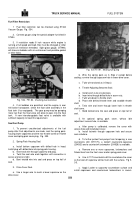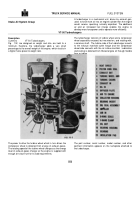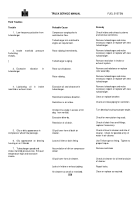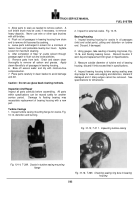TM-5-3805-254-14-P-2 - Page 559 of 894
TRUCK SERVICE MANUAL
FUEL SYSTEM
Operation and Maintenance
Correlated action of compressor and turbine automatically
adjust speed and output of turbocharger to compensate
engine speed and load changes.
Consideration
need
not
be
given
to
direction
of
turbocharger rotation when applied to right-hand-left-hand
engines Turbocharger rotates in only one direction, regard less
of direction of engine rotation.
Under continuous load operation, exhaust smoke from a
turbocharged engine should not be too dense, however, rapid
acceleration may cause a turbocharged engine to show
exhaust smoke of greater density for a few seconds until the
turbocharger rpm catches up with sudden increase in fuel
supply.
Starting And Initial Checks
1.
Prelubricate turbocharger by pouring clean lubricating
oil through inlet opening.
Turn rotating assembly by hand to
coat bearings and thrust washer with oil.
2.
Install oil inlet line and fill with clean lubricating oil.
Use wire braid hose with minimum inside diameter of 5/16 inch
[7.9 mm] (SAE No.
6) that will withstand up to 450 deg.
F
[232 deg.
C] oil temperatures.
3.
During initial starting, check for oil pressure at inlet
connection to turbocharger (10 psi [69 kPa] minimum at idle).
4.
Disconnect oil drain line to determine If oil is flowing
through turbocharger.
Reconnect line.
5
Remove air inlet connection from turbocharger and
observe rotation of turbocharger rotor.
The rotor must be
entirely free of any evidence of rubbing or binding.
6.
Shut down engine momentarily to determine If rotor
coasts freely to a stop
7.
Restart engine and check full speed and load.
8.
Recheck all connections and piping for tightness.
If no leakage of oil, air or exhaust gas can be noted, the
engine is ready for operation.
9.
Performance of turbocharger must be observed at
reasonable intervals.
Data and conditions to be observed are
noted in following paragraphs
Engine Shut-Down
It Is important to Idle an engine 3 to 5 minutes before shutting
it down to allow lubricating oil to carry heat away.
The turbocharger contains bearings and seals that are subject
to the high heat of combustion exhaust gases.
While the
engine is running, this heat is carried away by oil circulation,
but
If the engine
is stopped
suddenly, the turbocharger
temperature may rise as much as 100 deg.
F [38 deg.
C] .
The results of extreme heat may be seized bearings, bearing
housing deformation or burned "0" ring oil seals.
Place warning decal (Bulletin No.
983361B), Fig 103, In a
conspicuous location.
CAUTION
PROTECT THE
TURBOCHARGER
DURING
START-UP BY NOT OPENING
THROTTLE OR ACCELERATING
ABOVE 1000
RPM UNTIL NORMAL
ENGINE IDLE SPEED OIL PRESSURE
REGISTERS ON GAUGE.
SHUT-DOWN BY IDLING THREE
(3) MINUTES BEFORE SHUT-OFF.
Cummins Engine Company, Inc.
Columbus, Indiana, U.S.A.
47201
Bulletin No.
983361-B 7-70
Fig.
10-3, T-335-A.
Shut-down decal 983361-B
Lubricating Oil Flow
To check lubricating oil flow at turbocharger, loosen oil drain
line to see that oil is flowing while engine is running
Turbocharger oil must be kept clean by regular changing of
engine oil filter elements.
Turbocharger Speed
Ordinarily, attention need not be given to the speed of the
554
Back to Top




















